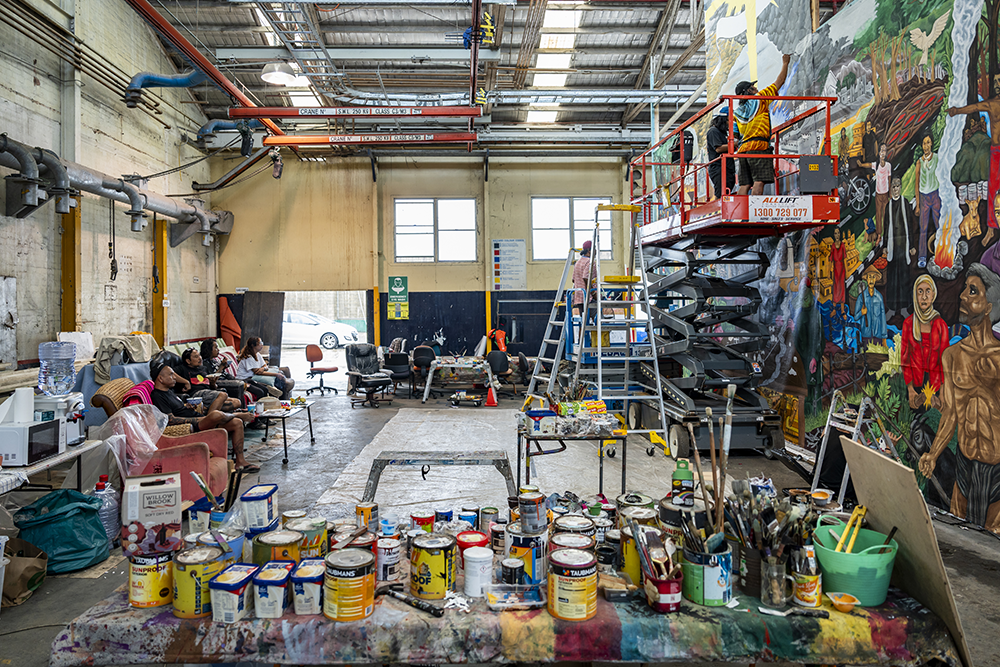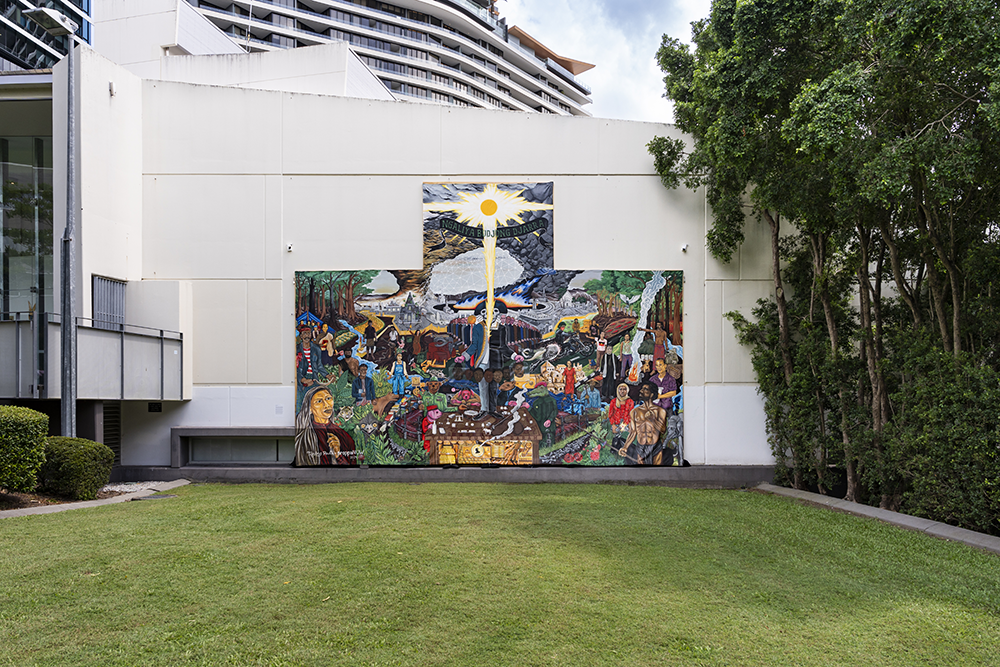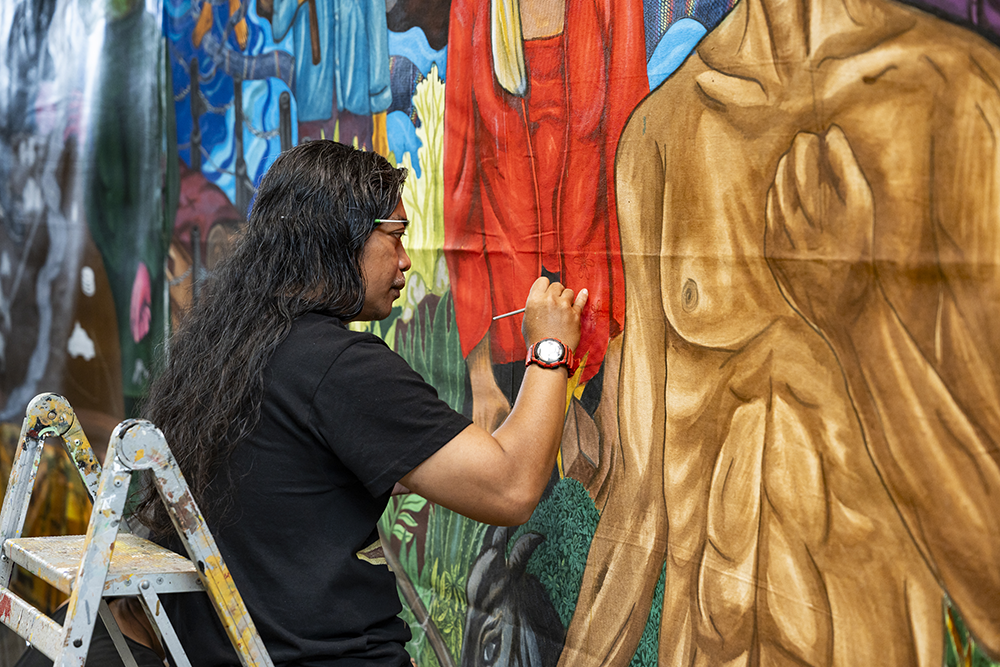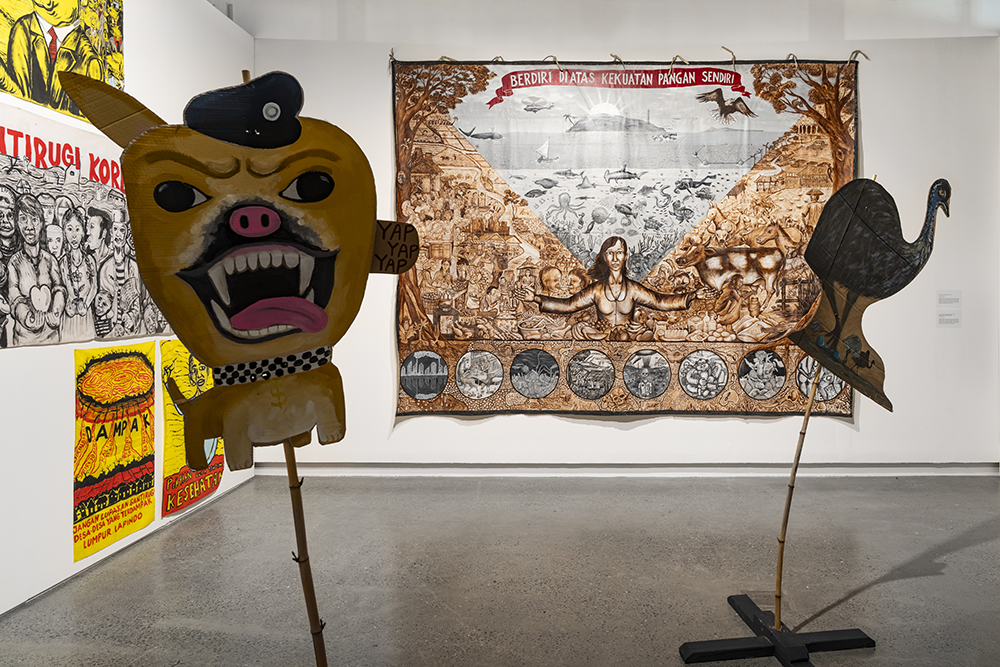.png)
The art world should not be reduced to be an endless series of shallow celebrations.[1]
First, let’s talk context.
Why?
Because active reading, active discussion, active interaction are threatened species in this time of the info-byte, the swipe left, the grab-it-and-go. And because a failure to provide some context would automatically reduce you, dear reader, like so many symposium goers and exhibition attendees in what we call the ‘art world’, into passive consumers of yet another cipher in ‘an endless series of shallow celebrations.’
This review focuses on an exhibition, symposium and associated projects under the title Taring Padi: Tanah Tumpah Darah at Griffith University Art Museum (GUAM), featuring the banners, prints and posters of Indonesian collective Taring Padi.[2] The exhibition’s centrepiece, a massive banner titled Ngaliya Budjong Djarra (2024) installed on the gallery’s external façade, is billed as
…the result of a cross-cultural collaboration between one of Australia’s most important Aboriginal art collectives, proppaNOW, and globally significant Indonesian artworkers collective Taring Padi.[3]
Terms like ‘collaborative’, ‘community’ and ‘collectives’ suggest exciting possibilities for challenging the star-making individualism fuelled by the commercial gallery network. It’s fair, therefore, to examine the extent to which any critique of passive consumption was upheld or thwarted by the GUAM program.
Taring Padi’s visual art productions have been made in collaboration with communities they have worked with for over 25 years, indeed since the collective was established in Yogjakarta in 1998. Many of these communities are impoverished, or face uncertain futures, threatened by ecological and environmental crises. Despite its diversity of collaborators, a recognisable graphic style unites the works, while no single artists are attributed in Taring Padi’s visual outputs. They deliberately eschew [individual] authorship by stamping works with the collective’s distinctive logo: a stylised rice store grain. They locate their collaborative practice in the processes that lead up to the making of the work, during which time the collective consults and plans with community members. Judging from their videos and documentation, the works produced–banners, puppets, prints, music, theatre–are often used as integral parts of festivals and marches that in turn foster unity and collective solidarity among local communities in resistance against the injustices that threaten their wellbeing.

In February 2024, fourteen members of Taring Padi were invited by GUAM for a month-long residency to paint Ngaliya Budjong Djarra in collaboration with proppaNOW, promoted on the premise of the two arts collectives’ similarities. As GUAM’s marketing material outlines,
Taring Padi and proppaNOW’s shared interests in land rights, sovereignty, and freedom of expression speak to shared experiences of Indigenous and urban communities in Australia and Indonesia, overcoming experiences of displacement and exploitation, and an ongoing sense of determination, survival, and strengthening of cultural traditions.[4]
But it would be a glib sleight of hand to infer that those ‘shared interests’ suggest more similarities than differences, an irony not lost on proppaNOW member Gordon Hookey when he quipped during the “Collective Aesthetics” session of the symposium, ‘In sports terminology, I guess you could describe proppaNOW as a team of champions whereas Taring Padi is a champion team’. Hookey’s one-liner corrects any assumptions that the (often conflated) terminologies of ‘collective’ and ‘collaborative’ didn’t need further unpacking.
No need to wonder, then, why the look of the collaborative banner heralding GUAM was stylistically coherent with Taring Padi’s former productions. Most of the collaborative aspect of the production occurred through ‘discussion, notes and sketches’ when proppaNOW member Richard Bell visited Taring Padi members in Yogjakarta before the collective flew to Australia. On arrival, harnessing the usual Taring Padienergetic approach, members worked continuously on what would become the central banner, taking breaks only to share food (their cooking skills are almost as legendary as their art practice), play music together and give time to nongkrong–that culturally invaluable Indonesian practice of devoting time to hang out together.
ProppaNOW members dropped in and out of the process on site at the Yeronga Paint Factory, with Gordon Hookey regularly contributing good humour and paint skills. As the weeks moved forward, the capacity for engaging in nongkrong gradually cemented ties between members of the two collectives in a range of ways. However, the prospect of opening the process up to other Meanjin / Brisbane collectives, communities and individuals did not eventuate.

Many members of Taring Padi have engaged with art events and communities in Australia before. In 2007, they were part of the Arts and Human Rights research project, Thresholds of Tolerance held at ANU School of Art Gallery. In 2023, member Aris Prabawa’s had a solo exhibition, Flame of Power, and in 2019-20 his work was featured as part of The Partnershipping Project, both at Lismore Regional Gallery.
However, proppaNOW member Richard Bell and Taring Padi members first met in 2022 at documenta 15 in Kassel, Germany, when their work was included in what promised to be a ground-breaking curatorial initiative designed by Indonesian collective ruangrupa, one that seemed set to turn many of the commercially driven aspects of the global art world on its head. Instead of a rollcall of international art stars, ruangrupa’s brief focused on the capacity of visual arts collectives to work at grassroots levels in powerfully game-changing ways. Tragically, the enormous potential of that ambitious curatorial initiative was hijacked by an incident that took all the oxygen out of any possible positive debate. When one of Taring Padi’s early banner works, Peoples’ Justice (2002), was charged with exhibiting antisemitic imagery, the press, the documenta establishment and much of the public went wild.[5] The backlash has continued to be emotionally demanding for members of the collective; the invitation to come to Australia to work and exhibit offered a kind of temporary reprieve.

Inside its clean white cube, GUAM glitters from floor to ceiling like an Aladdin’s cave with Taring Padi’s immense banners, hanging cheek-by-jowl beside intricate woodcuts and linocuts, posters and flat cardboard cut-out puppets. There’s a visual syncopation to the installation, one that evokes the rapid-fire-delivery of the kecak chants running behind Balinese performances of the Ramayana–a kind of chop-chop-gossip rhythm as the creatures of the forest detail the contextual specifics of the age-old battle between good and evil. In the performed epic of the Ramayana, the frogs and monkeys play a similar role to that of the chorus in Greek tragedies–the voices and responses of ‘everyman’–the tittle-tat tales of the community that deliver realpolitik home to the audience. In the work of Taring Padi, a similar rhythm is visually carried through in imagery documenting the fight of the ‘little people’ against a succession of injustices.
This style of imagery has remained consistent across the 25 years the collective has operated as artist-advocate-activists, as an immediately recognisable, crowded composition teeming with short-sharp, jab-like mark-making. When colour is applied, it’s vivid rather than wistful. There’s continuity in the references, too. Hybrid human-animals–pigs and dogs and crocs and snakes–are used to connote ‘types’ in the struggle-to-power. The depictions of ‘the people’ include farmers, peasants, factory workers, families: the crowds from which individual heroes and leaders intermittently emerge. And there’s the phoenix–so often the phoenix–that somehow manages to soar upwards from the flames of each successive form of devastation.
Even with no knowledge of Indonesian tradition, history or politics, a perceptive viewer could harvest an encyclopaedic set of references and clues from these works. There is more than enough with which to make sense (or trouble) from the imagery and the broader social, political, cultural and environmental contexts in which the works were produced and speak back to. Localised iconography abounds, but the age-old references to ‘struggle-to-power’ communicate across time and cultures. There are villains, there is devastation, there are heroes and heroines. There are generous doses of humour, too. And the scale and ambition of the works, together with the fact that they’re exhibited as the product of a collaborative undertaking rather than as trophies of a singular artistic genius, are a powerful aspect of their impact.

When proppaNOW was conceived in or around 2003 (individual members have differing opinions about the exact date), their ambitions as a collective coalesced around a fundamentally different approach to Taring Padi’s in terms of their aims. The core objective that brought proppaNOW members together originally centred around a need to challenge the limiting cultural stereotypes driving the interpretation (and marketing) of Aboriginal art. They were not the first to recognise the contradictions within the categories used to describe contemporary Aboriginal art production such as ‘urban’, ‘remote’ and ‘traditional’. For at least a decade, critical reassessments had abounded around what might constitute contemporary Australian Aboriginal art, and whether such a category operated within or beyond the parameters of Australian art especially in relation to the rapidly globalising art world of biennials, triennials and international exhibitions. Such questions, together with the fact that the global art market interest in Aboriginal art was eclipsing the other Australian art in sales and value, presented a glass ceiling that looked, from the position of a group of Brisbane-based Aboriginal artists, well worth shattering.
As such, their shared aims included ‘breaking into’ representation in commercial gallery systems and major institutional exhibitions, and in so doing, dismantling assumptions about what Aboriginal art is and what it should be. The approaches of individual members were unique, but frequently shared an identifiable through-line: a wry and powerful use of ‘blak’ humour; harnessing cryptic textual responses to big ideas, often politically satirical; informed anthropological and historical revisionism; and challenges to the conservative limitations of long-running narratives that confined Aboriginal art within neo-primitivist parameters. Together, proppaNOW drew attention to the fact that around 80 percent of Aboriginal Australians live in urban areas, and that the disproportionate funding and support given to more ‘authentic’ Aboriginal artists living and working in regional and remote areas was not only unfair, but also obscured the fact that most Aboriginal contemporary artists were working in highly researched, informed and critically reflexive ways, addressing colonialism, capitalism and neo-liberalism and more.
In the decades that followed, individual members of proppaNOW have been extremely successful in breaking through institutional barriers that once side-lined their nascent production. Many are now well-recognised names within the relatively small, hermetically sealed and globally interconnected exhibition circuit in Australia and overseas. On the whole, these artists have tended to conform to singular, art-market-driven practices controlled by conventional western exhibiting systems, which stands in sharp contrast to the collaborative approach of Taring Padi. As Bambang Agung describes in his essay Taring Padi: Seni Membongkar Tirani (Art Dismantles Tyranny), the method of engaging via ‘Collective artworks…[is] a critique of the reification of art and the commodification of its artists.'[6]
Although both collectives have continued to experiment with the struggle for representation, agency and the distribution of power (although from different directions: proppaNOW from inside and Taring Padi other from beyond), GUAM’s symposium merges the two groups under the uncritical banner of “Collective Aesthetics” and thereby inhibits potentially productive interrogations about the differences in their approaches and practice. As a result, the opportunity to reflect more deeply on the promise of ‘dynamic discussion on Social Realism, land rights, and the interdisciplinary practices of art collectives'[7] failed to eventuate.
For audience members and symposium attendees who are unfamiliar with the different practices and approaches of Taring Padi and proppaNOW, the failure to provide a critical scrutiny of the term ‘collective’ inhibited the symposium’s possibility of assessing the benefits and shortcomings of the two approaches.
Membership of proppaNOW is proudly exclusive and deliberately limited, whereas membership of Taring Padi is more open, flexible and inclusive. According to its members,
With equity, diversity, and openness being paramount values, the collective embraces old and new members from different backgrounds and age groups whose multiperspectivism not only feeds and renews Taring Padi’s radical art practice, but also prevents the development of any form of exclusivity.[8]
Systems of support also determine the ways artist coalitions can work, which can be as limiting as they are extending. Taring Padi’s genesis at the close of the 1990s was established in the Indonesian Legal Aid Foundation (YLBHI). ProppaNOW’s place for nongkrong–or hanging out together–was often in and around the office of Jennifer Herd, who at the time lead the Bachelor of Visual Arts in Contemporary Australian Indigenous Art at the Queensland College of Art. Where an activist legal system continues to provide support for Taring Padi’s practice, much of the work produced by most proppaNOW members is supported and driven by the elite private gallery system.
Taring Padi speaks of an ‘activist ecosystem’ that
…enables new members to grow in an atmosphere where art and the praxis of life are interconnected, thus securing Taring Padi’s inclusive and non-hierarchical organisational structure.[9]
In contemporary Australia, the possibility of a framework that supports an interconnection of ‘art and the praxis of life’ sounds like (a) a desirable apparition from a fever-dream or (b) pie in the sky. Make no mistake, there are plenty of initiatives that connect art to ‘the praxis of life’; there are plenty of Australian artists who currently work with all kinds of communities facing all kinds of difficulties, and many of them are engaging in small-scale, often self-funded initiatives that fall well outside the interests and reach of Australian gallery systems, public institutions and funding bodies. It’s worth imagining that they, too, may have had some very worthwhile things to contribute to important conversations about ‘collaboration’, ‘community’, ‘collectives’ and ‘cross-disciplinary and intercultural practices’, especially at a time when so many artists in Australia are searching for new ways to engage and sustain their practices.
Artists ultimately pay the price, whatever approach they opt for. For Taring Padi, the long years of producing art and projects outside the commercial gallery system puts significant pressure on their ability to respond to the everyday demands of life. Their capacity to afford food, rent and family support depends on largely on income from merchandising. For the professional financially successful members of proppaNOW, as recognition of their work has grown, so have demands on their time corroded their capacity to work in the collective spirit that fuelled them in the early days. Ironically, many now employ teams of artworkers to produce, manage and distribute their work: such are the burdens on the contemporary artist when global demand is high.
When proppaNOW was awarded the 2022-2024 Jane Lombard Prize for Art and Social Justice, the international recognition ‘reignite(d) collaboration among old friends,’ and as member Tony Albert said, ‘It really blew us away, it lit a bit of a fire under us to keep going and pull the band back together.'[10] Since then, membership of proppaNOW has been reinvented.
Situations keep changing, often in highly ironic ways. Following the worldwide negative press that followed Taring Padi’s participation in documenta 15, their established approaches to the commodification of cultural production face new challenges. According to Taring Padi member Alexander Supartono, after the exhibition in Kassel, the group agreed to disburse the 600 cardboard puppets that were an integral part of their installation, so people could ‘take them home and use them as focal points through which to keep the conversations around the event going’. However, very quickly, individual puppets started popping up on the secondary market for re-sale at around 950 euros each, raising complex questions about who the beneficiaries of Taring Padi’s generosity should be and forcing members to reconsider their ideal that ‘no individual artist should be acknowledged as a co-author of the work’.[11]
Positions, points-of-view, approaches to artmaking and audiences keep changing with the changing demands of new contexts and situations. Which is as it should be. So what are we, as participants in the art world, left wanting from a public program like this? Initiatives like those spear-headed by Taring Padi, proppaNOW and a plethora of other much-less-visible visual arts collectives and projects have together made the call for an increased responsiveness for greater cultural, social and gender-inclusivity in visual art exhibitions and projects.[12] And while a surface survey of recent exhibitions, publications, symposia might suggest that there has been significant change in their capacity to respond to and redress imbalances of power, privilege, and agency, a closer look reveals that beneath the surface celebrations, very little redress to the imbalances of power has been achieved.
For sadly, all-too-many of these exhibitions and projects—as per the debacle following documenta 15—fail to follow through with the kind of realpolitik - that might challenge the old established orders that keep the globalised art world functioning. And regrettably, so much of the fight for recognition of broader cultural and gender inclusiveness has subsided into the collapse into the kind of cultural branding and identity-traps that keep arts communities and other communities divided and combative.
Some critics have observed that identity politics are used as part of a highly mediatised, tightly controlled and ongoing cultural war, one in which affiliation with ‘identity’ is sold to ‘those who are able to own or control little else’. In this scenario, identity and virtue-signalling are deployed as infosphere scare-snares that maintain a divisiveness that inhibits the power of collective action. So that instead, fear abounds. So that the threat of being ‘cancelled’ obstructs the potential power of interactive, inter-critically responsive engagement.
Could it be true that cultural identity politics has already been bought-out and re-sold back to us as opioids that program us to uncritically accept the terms used to describe what we do as artists, so long as we’re ‘handed the microphone’? Could it be true that we feel satisfied at the prospect of being part of this “endless series of shallow celebrations” so long as we’re prepared to uncritically accept the badges and labels we never knew we were asking for?
Footnotes
- ^ Benjamin Seroussi, “Seeking Restorative Processes,” in Taring Padi Reader: Tanah Tumpah Darah, ed. Angela Goddard (Brisbane: Griffith University Art Museum, 2024), 10.
- ^ In the symposium, Taring Padi member Dr Alexander Supartono described the title of the exhibition as an ‘an act of resistance that epitomises defending life’.
- ^ Ngaliya Budjong Djarra, Taring Padi and proppaNOW, 8,
- ^ Ngaliya Budjong Djarra, 8.
- ^ The incident has been documented and responded to in a number of essays and reports, including the author’s own writings: “Documenta 15: Ruangrupa's trial in radical hospitality’, Art Monthly Australasia, 334 (December 2022): 44-47. For further reading and listening see Griffith University Art Museum: https://www.griffith.edu.au/art-museum/whats-on/2024/taring-padi
- ^ Taring Padi, Seni Membongkar Tirani, (Lumbung Press: 2011), 11.
- ^ Griffith University Art Museum, Instagram post, 20 February 2024
- ^ Taring Padi, Errant Journal, n.d.
- ^ Taring Padi Reader: Tanah Tumpah Darah, ed. Angela Goddard (Brisbane: Griffith University Art Museum, 2024)
- ^ Vera List Centre for Art and Politics, 2022-2024 Jane Lombard Prize for Art and Social Justice, 21 October 2022
- ^ Dr. Alexander Supartono, Opening Keynote Lecture, Symposium Program for Taring Padi: Tanah Tumpah Darah, Saturday 2 March
- ^ At the time of writing, GUAM was planning more forums and seminars. It is anticipated that some of the issues raised here will be unpacked further.












